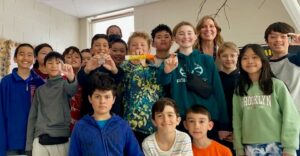Students make an important discovery about epinephrine – in space!
For the past seven years, students from various schools who take part in the gifted program at St. Brother André School in Ottawa, ON have participated in iEDU’s Cubes in Space™ program. This program is an international competition that provides the opportunity to design and test experiments on NASA missions, and winners get a chance to have a “cube” on board missions to test their theories.

As in past years, teacher Deborah Quail-Blier posed this question to her class: What kind of things would somebody need to know if they were travelling to space?
How the idea came about
This year, her students were interested in testing epinephrine, an essential medicine for treating anaphylaxis, a serious allergic reaction. They came up with this idea because some of their classmates have food allergy, and so many classes across the country have at least one student at risk of anaphylaxis. With the thought that people would be traveling to the moon, Mars, and more in their lifetime, they wondered if epinephrine would work if it went into space.
In Canada, there are three suppliers of epinephrine auto-injectors – EpiPen®, ALLERJECT®, and Emerade®, and these devices are used in the community to treat anaphylactic reactions.
Although the project posed some practical challenges such as how to have epinephrine contained in a 4 cm cube, the students were passionate about addressing what they considered to be a real-world issue. To learn more about the molecular structure of epinephrine, teacher Quail-Blier enlisted the help of Paul Mayer, a chemistry professor at the University of Ottawa.
What they set out to understand
Their project focused on understanding the effects of cosmic radiation on the molecular structure of epinephrine. At one point, they found out that there was an epinephrine auto-injector on the International Space Station, but they could not find any information that the medication had been tested upon return.
The experiment and findings
Their project earned two cubes – one for each of the platforms which Cubes in Space™ hosts. These platforms include a sounding rocket which goes to space on a short duration flight (about 7 minutes), and a research balloon which goes to near space, the stratosphere (minimum 8 hours). The idea was to compare the two platforms to better understand cosmic radiation by testing both epinephrine powder and epinephrine solution. The findings revealed that epinephrine did change, in particular no epinephrine remained in the solution samples. The results are shown below.
| Item | Rocket post- flight results | Balloon post-flight results |
| Pure epinephrine powder (solid) | No significant change in molecular structure | Change to 13% benzoic acid (87% epinephrine remained) |
| Epinephrine solution (liquid) | No epinephrine molecules | No epinephrine molecules |
The findings have provided a better understanding of the effects of cosmic radiation on epinephrine and have implications for space travel and astronaut safety.
The students’ project involved epinephrine in both solid and liquid forms. Interestingly, there is evolving research on needle-free options for the treatment of anaphylaxis, including nasal powder epinephrine and liquid nasal epinephrine options. (Check out our Listen and Learn audio episode on needle-free epinephrine for treating anaphylaxis with Dr. Harold Kim.)
Next steps
Last year’s findings need to be validated, and students are now working on a new application for a space flight. They are interested in sending more epinephrine to space and are researching materials to create a protective system for it.
Epinephrine is the only medicine that can treat anaphylaxis. Understanding how this medicine works in space can ensure that people can treat anaphylaxis confidently, even if they travel far and beyond!
Congratulations to teacher Deborah Quail-Blier and her students for their important discovery about epinephrine. We wish them continued success with their experiments involving this essential medicine.
Tags: Epinephrine, special feature